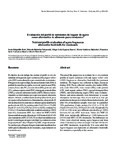
Please use this identifier to cite or link to this item:
http://ricaxcan.uaz.edu.mx/jspui/handle/20.500.11845/884| Title: | Evaluación del perfil de nutrientes de bagazo de agave como alternativa de alimento para rumiantes |
| Authors: | Delgadillo Ruíz, Lucía Bañuelos Valenzuela, Romulo Esparza Ibarra, Edgar León Gutiérrez Bañuelos, Héctor Cabral Arellano, Francisco Javier Muro Reyes, Alberto |
| Issue Date: | Jun-2015 |
| Publisher: | INIFAP |
| Abstract: | El objetivo de este trabajo fue evaluar el perfil in vitro de nutrientes de bagazo de Agave salmiana (AS) y Agave weberi cela (AWC) como alternativa para la nutrición de los rumiantes. El bagazo se recogió en Jalpa, Zacatecas durante el año 2010. A partir de las muestras recogidas, se evaluó: materia seca (MS), cenizas, fibra cruda (FC), extracto etéreo (EE), proteína cruda (PC), carbono orgánico total (TOC), detergente neutro de fibra (DNF), y azúcares reductores totales (ART). Macro y micro-minerales se determinaron por espectroscopia de absorción atómica. Además, se utilizó una técnica de producción de gas in vitro para evaluar la cinética de fermentación, y después de 48 h de incubación de las muestras se utilizaron para cuantificar la producción de AGV. La proteína cruda (%) (2.25 vs 2.73), EE (%) (0.274 vs 0.272), CF (%) (22.15 vs 16,58) y cenizas (%) (2.14 vs 1.81) no fueron diferentes estadísticamente (p> 0.05) entre AS y tratamiento AWC. Los valores de DNF (% MS) fueron estadísticamente diferentes (p< 0.05) entre el AS (45.45) y los tratamientos AWC (52.95). No se observaron diferencias en AGV entre bagazo de agave y de frijol. Los valores de calcio (%) promedio de 3.46 y 1.95 para AS y AWC, respectivamente. Se concluye que, el bagazo de agave representa una alternativa viable para la alimentación de rumiantes, especialmente en la estación seca. |
| Description: | The aim of this project was to evaluate the in vitro nutrient profile of Agave salmiana (AS) and Agave weberi cela (AWC) bagasse as alternative feedstuffs for ruminant nutrition. The bagasse was collected in Jalpa, Zacatecas during 2010. From collected samples, dry matter (DM), ash, crude fiber (CF), ether extract (EE), crude protein (CP), total organic carbon (TOC), neutral detergent fiber (NDF), and total reducing sugars (TRS) were evaluated. Macro- and micro-minerals were determined by atomic absorption spectroscopy. Also, it was used an in vitro gas production technique to evaluate fermentation kinetic, and after 48h of incubation samples were used to quantified VFA production. Crude protein (%) (2.25 vs 2.73), EE (%) (0.274 vs 0.272), CF (%) (22.15 vs 16.58) and ash (%) (2.14 vs 1.81) were not different statistically (p> 0.05) between AS and AWC treatment. Values for NDF (% DM) were statistically different (p< 0.05) between AS (45.45) and AWC (52.95) treatments. No differences on VFA’s were observed among agave bagasse and bean straw. Calcium (%) values averaged 3.46 and 1.95 for AS and AWC-treatments, respectively. It is concluded that Agave bagasse can represents an alternative feedstuffs for ruminants, especially at dry season. |
| URI: | http://localhost/xmlui/handle/20.500.11845/884 https://doi.org/10.48779/fe4a-cg48 |
| ISSN: | 2007-0934 |
| Other Identifiers: | info:eu-repo/semantics/publishedVersion |
| Appears in Collections: | *Documentos Académicos*-- UA Veterinaría |
Files in This Item:
| File | Description | Size | Format | |
|---|---|---|---|---|
| 10.- 2015 Delgadillo et al., 2015.pdf | 249,3 kB | Adobe PDF |  View/Open |
This item is licensed under a Creative Commons License
